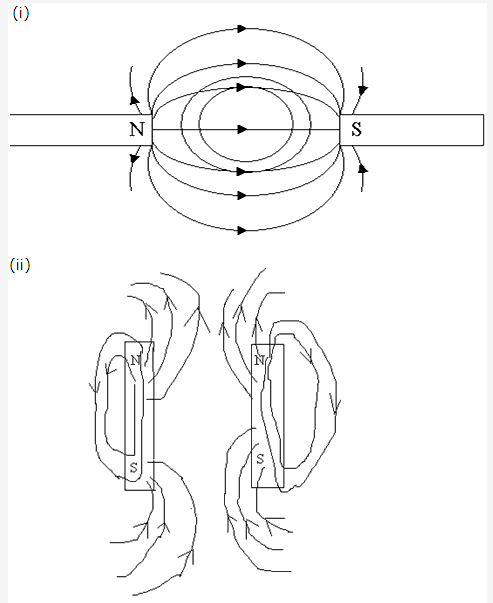Frank ICSE Solutions for Class 9 Physics – Electricity and Magnetism
PAGE NO: 323
Solution 1:
Positive and negative are the two kind of charges.
Solution 2:
Net charge on an atom is zero.
Solution 3:
10 is the number of electrons present in Na+.
Solution 4:
An atom does not have any net charge while ion is either a positive charge or a negative charged.
Solution 5:
The friction between two bodies when they are rubbed against each other is the reason of electrification.
Solution 6:
A lightening conductor is a device used to protect the large buildings against lightening during a thunderstorm.
Solution 7:
The speed of light is very fast as compared to the speed of sound in air. So, the thunder is seen fast and then we hear the sound of thunderstorm.
Solution 8:
Electroscope is used to determine the nature of the charge and to detect the presence of charge on the body.
Solution 9:
When a positively charged rod is brought near the positively charged cap then , the positive charge on the cap will spread over because of repulsion and some of them will reach to the leaves . Now, the leaves will have the same positive charge , they will repel each other and hence, leaves will diverge.
Solution 10:
The flow of electrons in a particular direction is called direct current.
Solution 11:
The two differences between primary and secondary cell are :
- Primary cells cannot be charged again while secondary cells can be charged again and again.
- In primary cells, chemical reaction is irreversible while in secondary cells , chemical reaction is reversible.
Solution 12:
S.I. unit of current is ampere.
Solution 13:
A battery is the made up of multiple cells.
Solution 14:
Current is a scalar quantity.
Solution 15:
Current is defined as the rate of flow of charge.
Solution 16:
A milliampere is bigger than microampere.
Solution 17:
Rheostat is other name of variable resistor.
Solution 18:
A cell and battery are the two sources of current.
Solution 19:
No, voltmeter is not the same as voltameter.
Solution 20:
Ammeter is used to measure the magnitude of current in the circuit.
Solution 21:
Electrons flow inside the metallic conductor and a battery and cell helps in the movement of electrons in it.
Solution 22:
Voltmeter has high resistance than the ammeter.
Solution 23:
An artificial magnet is the magnetized piece of iron or steel.
Solution 24:
Voltmeter is always connected in parallel to the circuit.
Solution 25:
Ammeter is always connected in series in the circuit.
Solution 26:
S.I unit of resistance is ohm.
Solution 27:
The resistance of conductor is 1 ohm when a current of 1 ampere flows through it when the potential difference across it is 1 volt.
Solution 28:
I = Q/t = 0.8/5 = 0.16 Ampere.
Solution 29:
Rheostat is an instrument to control the current in the circuit.
Solution 30:
Horse-shoe magnet is the shape of the magnet. This shape helps in bringing the poles near to each other and make the strong magnet.
Solution 31:
The magnetism acquired by a magnetic material when it is kept near a magnet is called induced magnetism.
Solution 32:
The points of the magnet where attraction appears the maximum are called poles of magnet and they are situated at ends of the magnet.
Solution 33:
The differences between primary and secondary cell are :
- Primary cells cannot be charged again while secondary cells can be charged again and again.
- In primary cells, chemical reaction is irreversible while in secondary cells , chemical reaction is reversible.
Solution 34:
A cell is a source of energy which converts the chemical energy into electrical energy. The cell consists of two electrodes in the form of conducting rod immersed in the solution called electrolyte.
Solution 35:
I = Q/t = n e/t
So, n = I.t / e = 1. 1 / 1.6 x 10-19 = 6.25 x 1018
So, 6.25 x 1018 will be the number of electrons.
Solution 36:
Q = I.t = 4.5 x 2.5 = 11.25 C.
Solution 37:
A key is used to put the current on and off in the circuit.
Solution 38:
The effect to rate of flow of current by the wire is called its electrical reistance. Its S.I unit is ohm.
Solution 39:
The resistance of the wire depends on the following factors :
- Length of the wire
- Cross-section of the wire
- Temperature of the wire.
- Material of the wire.
Solution 40:
With increase in temperature of the wire, the resistance of wire increases.
Solution 41:
The resistance of wire will become 4ohm.
Solution 42:
Variable resistors consist of a resistance track with connections at both ends and a wiper which moves along the track as you turn the spindle. The track may be made from carbon, cermet (ceramic and metal mixture) or a coil of wire (for low resistances). The track is usually rotary but straight track versions, usually called sliders, are also available.
A variable resistance is a device used to change the resistance and hence the current flowing through a circuit; without changing the voltage.
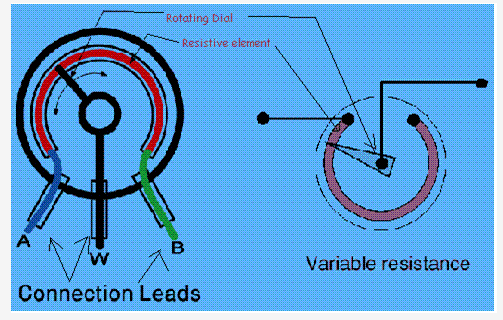
Solution 43:
Galvanometer is used to detect the direction of current as well as to detect very weak current. Ammeter is used to measure the magnitude of an electric current in the circuit.
Solution 44:
Voltmeter is used to measure the potential difference between two points in the circuit. Voltameter is an instrument for measuring the voltaic electricity passing through it, by its effect in decomposing water or some other chemical compound acting as an electrolyte.
Solution 45:
The magnets (pieces of lodestone) found in nature is called natural magnet. The properties of magnet are :
- Attractive propery
- Directive property
- like poles repel while unlike poles attract.
Solution 46:
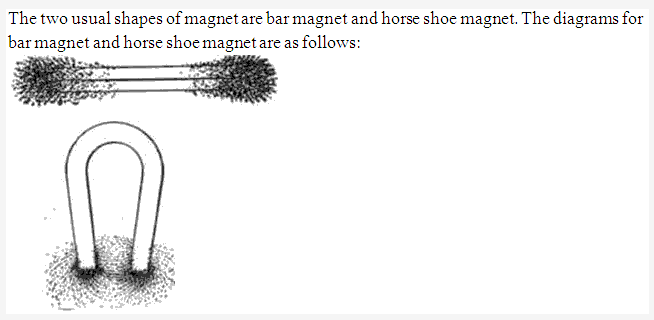
Solution 47:
The mechanism in which magnetism acquired by the magnetic material when kept near a magnet is called magnetic induction. When the magnetic material get magnetized, the pole developed on its side will be opposite to the magnet’s pole taken near to it. So, opposite poles attract each other. So, induction causes attraction.
Solution 48:
We will start drawing the magnetic field of lines from the north pole of magnet. When a small compass is placed at a point near the north pole of the magnet , the needle turns round on its pivot and settle in the fixed direction. At other points away from the pole the needle settles tangent to the drawn field line. By plotting the directions indicated by the needle, we can draw magnetic field of lines.
Solution 49:
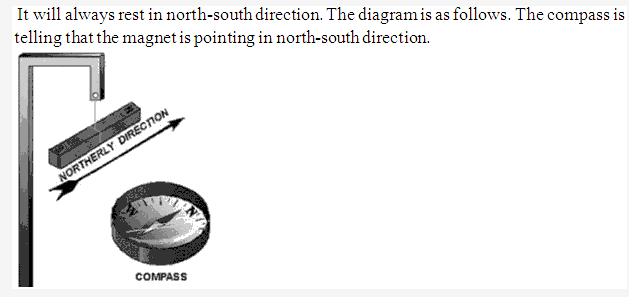
PAGE NO : 324
Solution 50:
The magnetic field of lines are the lines which get formed by joining the poles of the magnet and they are the continuous curves in which tangent drawn to it will give the direction of magnetic field.
Solution 51:
By breaking the magnet into two halves, magnetic strength will always get half.
Solution 52:
By breaking the magnet into two halves, magnetic strength will always get half. So, the raio of magnetic strength will be 1:2.
Solution 53:
- The charge gained by the B will be positive charge
- The B will be charged by the charging by contact. The charge on A will spread on B.
Solution 54:
Electroscope is the device used to detect the presence of charge and the nature of charge on the body. The four stages of the charging a gold leaf electroscope by induction are :
(i) Bring a positively charged rod near the cap of an electroscope. The cap will acquire the negative charge on it by induction. The leaves will diverge
(ii) Earth the electroscope by touching the cap will finger.
(iii) Remove the finger and keep the positively charged rod as such.
(iv) Now, take away the rod. The leaves will diverge because of charges induced by induction.
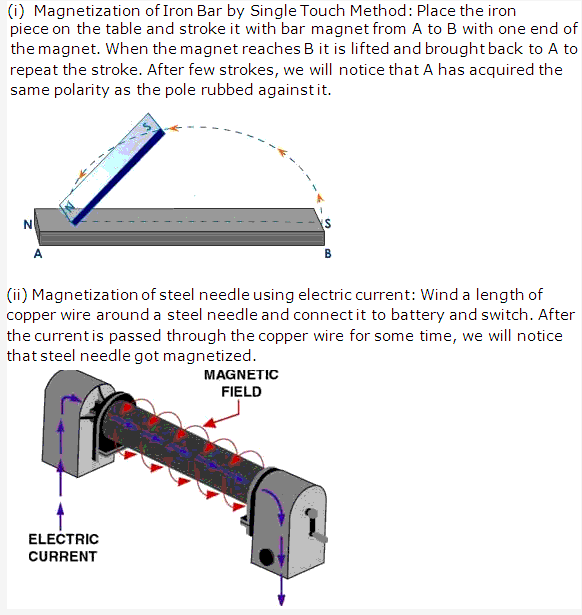
Solution 55:
Electrostatic induction is the process of charging a body by bringing another charged body near to it. When the X will come near to body B, the opposite charge will be acquired by body B. So, negative charge will be acquired. Similarly, by electrostatic induction, A will acquire the opposite charge of B so A will acquire the positive charge.
Solution 56:
- Lightening conductor is a device used to safeguard the large buildings against lightening of thunderstorm. Normally, they are fitted on the top of tall buildings as a safety device. It consist of few metal spikes fitted to the highest part of building and connected to thick copper strip which is buried inside the earth .
- Resistance of the conductor: It is the property of the conductor by virtue of which it obstructs the flow of current in the circuit.
- Potential Difference: It is defined as the amount of work done in moving a charge from one point to another .
- Open Circuit: In the circuit, if the switch is off or the wire is cut then flow of current in circuit stops and we say that its an open circuit.
- Closed Circuit: The circuit in which current flows without any obstruction then it’s a closed circuit.
Solution 57:
- When two bulbs will connect in series then resistance of the circuit will increase so the brightness of the bulbs will decrease.
- When the two bulbs will be connected in parallel then resistance of circuit will decrease so the bulbs brightness will increase.
Solution 58:
- Differences between Conductor and insulators::
- Conductors allow passing of electric current through it. Insulator does not allow passing of current through it.
- Silver, Gold are good examples of conductor of electricity. Rubber, Cotton are good examples of insulators.
- Flow of electrons is the flow of negative charges inside the conductor while flow of conventional current is the flow of positive charges inside a conductor.
- Primary cells are the cells in which chemical reaction is irreversible so they can’t be charged again and again. While , secondary cells are the cells in which chemical reaction is reversible and can be charged again and again.
Solution 59:
- Following are the properties of magnet
- Like poles of magnet repel each other while unlike poles attract.
- Magnet have an attractive property means it attract the magnetic material towards it.
- Magnet have the directive property means when it is held freely , it always point towards north-south direction.
- The Laws of Magnetism: Like poles repel each other and unlike poles attract each other.
- Magnetic materials get attracted towards the magnet but non-magnetic materials does not get attracted towards the magnet.
- Natural magnets are the pieces of lodestone which are found in nature while artificial magnet is the magnetized piece of iron or steel.
- Iron has high susceptibility and low retentivity means it acquires the magnetism faster and removes it soon as well. While , steel has low susceptibility and high retentivity.
Solution 60:
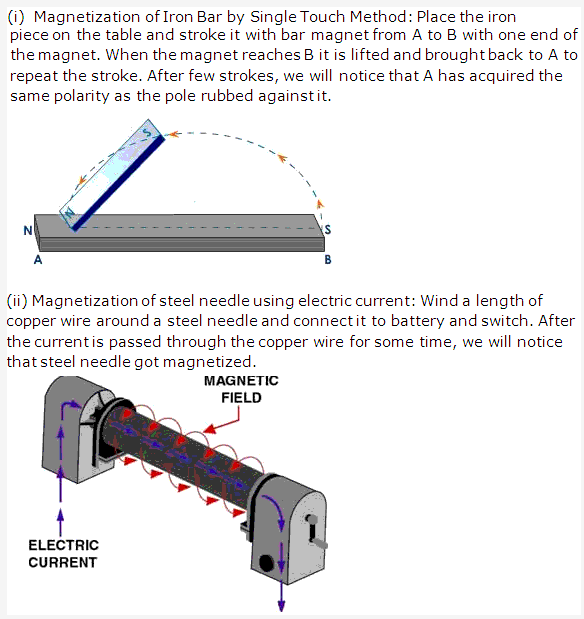
PAGE NO : 325
Solution 61:
- Magnetic induction is the process in which magnetism is acquired by the magnetic material when a magnet is brought near it.
- If we had a magnet then we will bring the magnet near to steel , if there is force of repulsion or attraction is experienced then steel was magnetized otherwise not.
- We will held the steel freely, if it points to north-south direction only then it is magnetized otherwise not.
- Magnetic Meridian: It is the vertical plane containing the magnetic axis of a freely suspended magnet at rest under the earth’s field.
- Geographic Meridian: It is the vertical plane containing the geographic north and south poles of the earth and passing through the given place in the surface of earth.
- Angle of declination: The angle between geographic and magnetic meridian is called angle of declination.
- Angle of Dip: The angle between the horizontal and earth’s magnetic field is known as angle of dip.
Solution 62:
- When a nylon shirt , blouse or stocking s are removed then they get rubbed with the hairs and due to friction between hairs and nylon, charges get induced on them and attractive force get induced between them.
- The rubbed ebonite rod contains more electrons so it acquires the negative charge so a charged is acquired by it. But, in the rubbed metal rod , electrons are transferred but through hands and body they pass to the earth so no charges will be there while metal rod is held in hand.
- Soft iron is used to make electromagnets because it has high susceptibility and low retentivity , it get magnetized very faster and loses magnetism as soon as the inducing magnet is removed.
- Two steel needles hanging from the lower end of the vertical bar magnet do not hang vertical but will diverge because they got the like poles on it and like poles repel each other so they diverge.
- If magnetic material is brought near to the magnet then it get attracted although its not magnetized but the magnetic material will be repelled only in case it is magnetised. So repulsion is the sure test of magnetism.
Solution 63:
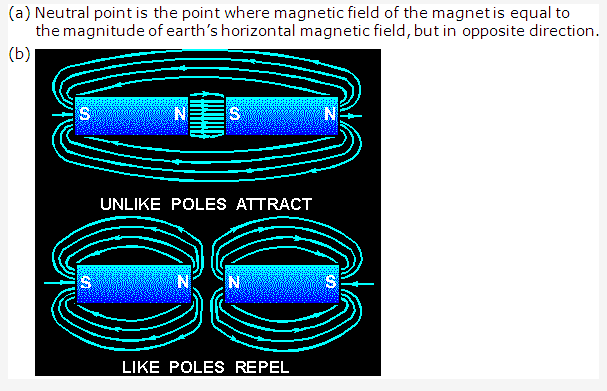
Solution 64:
Disadvantages of setting up large dams for hydro-electricity power station::
- It leads to large catchment area being submerged
- displacement of people from their places.
Solution 65:
Improved practices in the use of energy :
- Use the improved cook stove which will save the bio-mass energy
- Use the improved solar panels and solar furnaces.
Solution 66:
The functions of bureau of energy efficiency setup are :
- control and keep an eye on consumption pattern
- develop appliances suitable for the energy change
- organize posters and slogans for developing awareness in society.
Solution 67:
- At School: Use of solar cells to light up the electricity in schools and do rain water harvesting, keep the electrical appliances off after the needed period of time.
- At Home: Use of bio energy for cooking and lightening, use CFLs instead of filament bulbs, keep the electrical appliances off after the needed period of time.
Solution 68:
